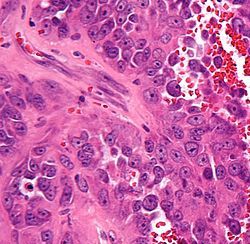Olaratumab Added to Doxorubicin-based Chemo May Improve Safety in Select Patients With Advanced STS
The addition of olaratumab to doxorubicin-based chemotherapy resulted in similar response and stable disease rates between patients with advanced soft tissue sarcoma and a good performance status, but provided an improved safety profile that favored the olaratumab cohort, according to results reported at the 2018 CTOS Annual Meeting.

The addition of olaratumab (Lartruvo) to doxorubicin-based chemotherapy resulted in similar response and stable disease rates between patients with advanced soft tissue sarcoma (STS) and a good performance status, but provided an improved safety profile that favored the olaratumab cohort, according to results reported at the 2018 CTOS Annual Meeting.1
“Patients with advanced STS still face a median overall survival of 12 to 16 months and the 2-year overall survival rate is approximately 30% when treated with doxorubicin-based chemotherapy,” commented Andrea P. Espejo, MD, of the Department of Internal Medicine, University of Miami Miller School of Medicine, Jackson Health System, in Miami, Florida, during a poster discussion session.
Espejo and colleagues conducted a retrospective case-control study identifying 12 consecutive patients treated with olaratumab plus a doxorubicin-based doublet regimen and 24 consecutive patients receiving a doxorubicin-based doublet regimen alone as the control group. The 2 groups were matched for age and race. All patients had an ECOG performance status of 0 to 1, and stage III or IV STS. The median patient age was 55 years (range, 17 to 76) in the case group versus 64 years (range, 21 to 80) in the control group. Although cardiovascular risk factors were equivalent (41%) in both cohorts, 41% of cases versus 8.3% of controls had a history of other malignancies.
“Olaratumab in addition to doxorubicin showed a survival advantage of 11.8 months over single-agent doxorubicin without adding significant toxicity,2,3but whether this regimen is effective and tolerable in patients with a good performance status is unknown,” she explained.
Olaratumab is a first-in-class anti-PDGFRA monoclonal antibody that has been contingently approved for use in combination with doxorubicin to treat adult patients with advanced soft tissue sarcoma, based on improved progression-free and overall survival.
“In patients with good performance status, the initial responses in cases versus controls were similar after 2 to 3 treatment cycles,” she remarked.
In this study, a comparison of case patients to control patients by RECIST criteria revealed that 66% of patients in the case group had achieved stable disease (SD) versus 71% of controls and 16% of cases achieved a partial response (PR) versus 12.5% of controls; 1 case patient (8%) had progression of disease (PD), whereas no controls showed PD.
By Choi criteria, 41% of case patients had SD versus 20% of control patients, 33% of patients in the case group had a PR versus 54% of controls, and 16% of cases had PD versus 8% of controls. The disease control rates were 83% for both cases and controls by RECIST criteria and 75% each by Choi criteria.
“Our study is limited by its retrospective design and small size. Additionally, the median number of cycles received in the olaratumab group was 3 compared to 5.5 in the control group, which may account for cumulative toxicity and explain, in part, our results,” Espejo explained.
Interestingly, the addition of olaratumab showed a trend towards fewer adverse events (AEs), with the odds ratios (ORs) of having an AE all favoring olaratumab. The OR for all AEs was 0.67 (95% CI, 0.48-0.93;P= .0164), the OR for a grade 1/2 AE was 0.72 (95% CI, 0.47-1.11;P= .139), the OR for a grade 3/4 AE was 0.65 (95% CI, 0.42-1.00;P= .0519), and the OR for a clinical AE was 0.16 (95% CI, 0.1-0.23; P<.0001). Regarding hematologic AEs, the OR of having a grade 1/2 AE was 1.6 (95% CI, 0.53-4.98;P= .3958), and the OR for having a grade 3/4 hematologic AE was 0.43 (95% CI, 0.21-0.87;P= .02).
“In patients with a good performance status, the addition of olaratumab to doxorubicin-based chemotherapy did not appear to add significant toxicity and a trend toward a protective effect was observed; this result is discordant with the Tap et al phase II study where AEs were higher in the olaratumab group,” she said.
“These data support the feasibility of adding olaratumab to doxorubicin-based combination regimens in patients with advanced STS and good performance status. Prospective trials will determine whether this translates into better outcomes,” Espejo concluded. “Further prospective clinical trials will help determine whether adding olaratumab to chemotherapy translates into better outcomes in patients with STS.”
References:
- Espejo AP, Florou V, Subhawong TK, et al. Safety and efficacy of olaratumab Safety and efficacy of olaratumab added to doxorubicin-based combination chemotherapy in the treatment of advanced soft-tissue sarcoma (STS). Presented at: 2018 CTOS Annual Meeting; November 14-17, 2018; Rome, Italy. Poster 110.
- Zobniw CM, Trinh VA, Posey K, Somaiah N. Olaratumab in the management of advanced soft tissue sarcoma [published online January 1, 2018]. J Oncol Pharm Pract. doi: 10.1177/1078155218788135.
- Tap WD, Jones RL, Van Tine BA, et al. Olaratumab and doxorubicin versus doxorubicin alone for treatment of soft-tissue sarcoma: an open-label phase 1b and randomised phase 2 trial. Lancet. 2016;388(10043):488-497. doi: 10.1016/S0140-6736(16)30587-6.
PTCy Offers New Hope for Mismatched Stem Cell Transplants in Leukemia, MDS
April 13th 2024Jeff Auletta, MD, discussed how PTCy-based graft-vs-host disease prophylaxis offers a promising approach for expanding access to successful cell transplantation regardless of donor match or patient ethnicity.
Read More